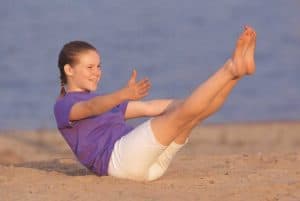 Monkeys love to pick bugs and little eggs out of their friends’ fur and eat them. It’s called nit picking. Their arm-spread is longer than the length of their whole body. They easily arm-walk through the trees. They also knuckle-walk on the forest floor.
Monkeys love to pick bugs and little eggs out of their friends’ fur and eat them. It’s called nit picking. Their arm-spread is longer than the length of their whole body. They easily arm-walk through the trees. They also knuckle-walk on the forest floor.
Instructions
- Bend your knees and squat down on your feet. Walk around. Lead with your long arms and jump with your bent legs. On a soft surface, try ‘knuckle walking.’
- Check each other for bugs and nits. Pick them out and pretend to eat them.
- Make monkey sounds. Roll your lips away. Bare your teeth. Breathe with a “he he he” sound.
- Make monkey lips and breathe with a “who, who, who sound.” Go back and forth.
You’ve cleaned each other up and fed yourselves too. Good monkeys! Reward yourself with a banana!
Activity Ideas for Home or Classroom
Bridge of Diamonds
Cooperation and taking care of one another is a good idea for all living things.
Math Medley
You picked ___ nits. Your friend picked ___. How many nits did you pick together?
Musical Musings
Sing to the melody of Five Little Monkeys.
“Bug pickin chimps went swinging through the trees.
They laughed and sang and breathed hee-hee.
Cleaned their fur til their coats were nit-free
Then shared big bananas for all to see.”

 Have you ever rowed a boat? If not, give it a try right now! Rowing takes strength and coordination. You use your tummy, back, arm and shoulder muscles. Your body works hard, yet the oars just dip gently in the water without making too many waves. Put on your life jacket and get ready for a ride!
Have you ever rowed a boat? If not, give it a try right now! Rowing takes strength and coordination. You use your tummy, back, arm and shoulder muscles. Your body works hard, yet the oars just dip gently in the water without making too many waves. Put on your life jacket and get ready for a ride! Go ape! Pound your chest. Howl like a monkey. Stay happy, healthy and energized with this fun YogaKids pose.
Go ape! Pound your chest. Howl like a monkey. Stay happy, healthy and energized with this fun YogaKids pose.